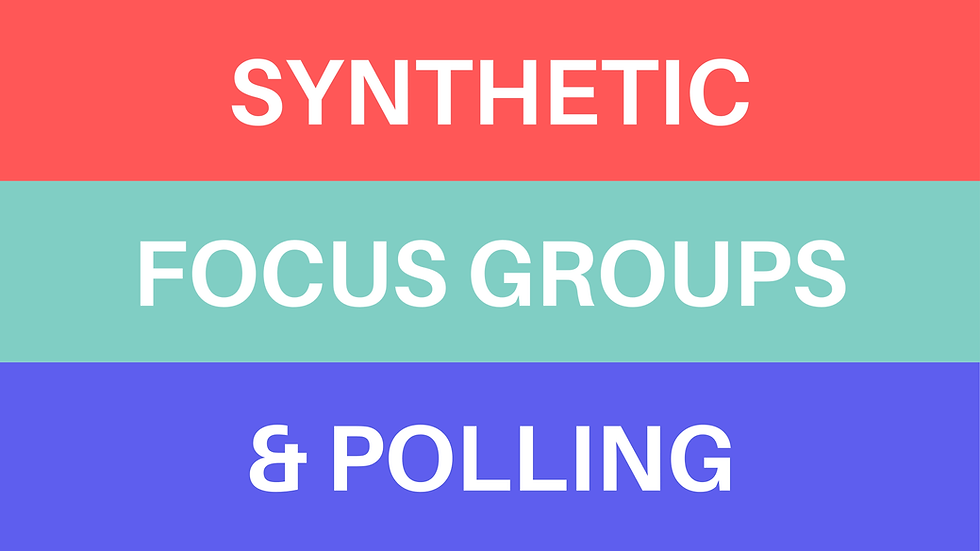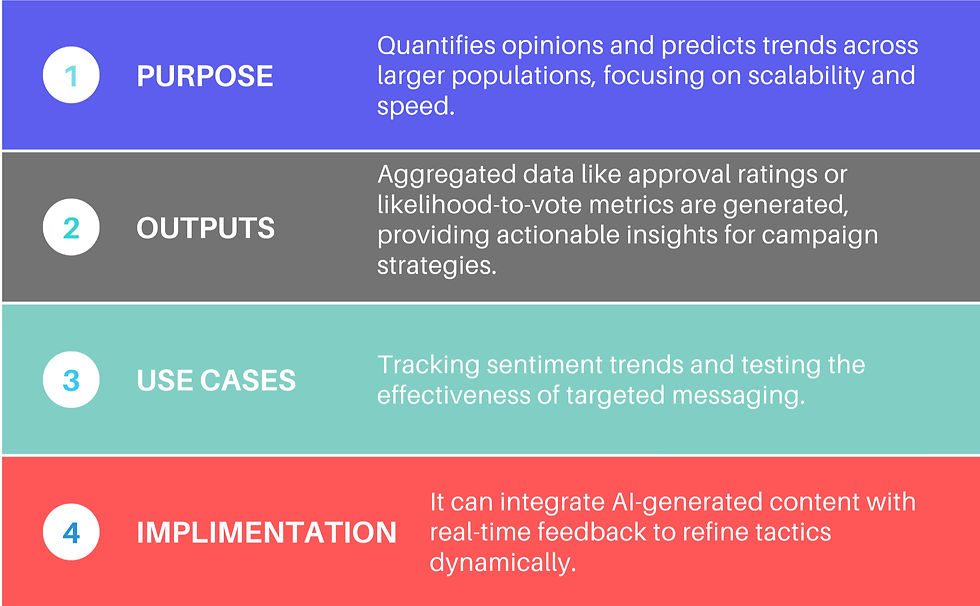AI-Focus Groups and Polling will change political campaigns within 5 years.
- Jochen König
- 23. Jan.
- 4 Min. Lesezeit

Traditional opinion polls and focus groups continue to dominate election campaign planning and decision-making. This will change. As someone engaged with innovation in political technology, I’ve been observing a parallel trend: emerging AI solutions for Synthetic Focus Groups and Synthetic Polling. These AI fueled approaches hold the potential to reshape how we plan political campaigns and voter engagement within the next five years, even if their practical application in Germany/Europe is still in its infancy.
Synthetic Focus Groups vs. Synthetic Polling: What’s the Difference?
Having worked with traditional focus groups and polling, I’ve seen firsthand how labor-intensive and costly these methods can be. Synthetic approaches, by contrast, are designed to deliver similar insights in a fraction of the time and cost. Synthetic methods aim to address these challenges by using AI models to simulate voter behavior and sentiment efficiently. From my perspective, it’s essential to differentiate these two concepts, as they serve distinct purposes in understanding voter behavior and testing campaign messages:
Synthetic Focus Groups
Synthetic focus groups can generate detailed, human-like responses tailored to specific demographic profiles. For example, a campaign could create a simulated discussion among women aged 30 to 50 in Bavaria about climate policies. These outputs closely resemble traditional focus group transcripts and can be produced rapidly and cost-effectively.

Synthetic Polling
Synthetic polling complements this by enabling campaigns to test messages, predict voter reactions, and refine strategies dynamically. This process integrates AI-generated materials, such as video ads, with feedback mechanisms to inform decision-making more efficiently.

The 6-Step Strategy for Using Synthetic Tools in Campaigns
In my experience, the integration of synthetic tools into campaign strategies could be mapped out as follows:
1.Identifying Core Issues:
Automated systems analyze large datasets, such as recent news articles and demographic statistics, to identify the most significant voter concerns. For example, in past campaigns, key issues like cost-of-living crises and leadership style emerged as defining topics
These insights are generated rapidly, providing rough but actionable data for decision-making.
2.Content Generation:
Campaign strategists use AI tools to create targeted content, such as a 30-second video ad designed to resonate with specific voter segments (e.g., women aged 30–50 in Bavaria).
This content is crafted based on identified core issues and tailored to demographic nuances.
3.Synthetic Polling:
The AI-generated content is then tested using synthetic polling, which evaluates its impact on voter sentiment. For instance, it determines whether the video ad successfully communicates the intended message or evokes the desired response.
Synthetic polling provides near-instant feedback, enabling iterative refinement of campaign materials.
4.Personalization at Scale:
AI systems generate individualized appeals or messages for specific voter subgroups, leveraging commercially available, aggregated data. This ensures that outreach efforts are both personalized and efficient.
5.Deployment and Monitoring:
The optimized materials are deployed across relevant channels (e.g., social media, email campaigns), while real-time monitoring tools track their effectiveness and allow for further adjustments if necessary.
6.Strategic Iteration:
Insights from the initial cycle are fed back into the system, ensuring a continuous loop of refinement and adaptation to emerging voter concerns and campaign dynamics.
First Start-Up with ties to Cummings, Brexit, and The Guardian Received Funding
I started talking about synthetic polling and focus groups in spring 2024 with senior data specialists who had worked in leading positions in campaigns and for party headquarters. Our first ideas were exciting, and even within the limitations of DSA and GDPR, we came up with approaches that hold potential. A couple of months later, I stumbled upon an article about Electric Twin, a UK-based company at the forefront of developing AI-powered technologies for synthetic focus groups and polling.
The company was founded in late 2023 by Ben Warner, a former senior official in Number 10, with close ties to Dominic Cummings. In December 2024, the start-up announced its seed-round north £2 million. The venture arm of the Guardian Media Group, called “Mercuri", is one of the new investors in Electric Twin. Ben Warner had already worked on the Brexit Leave campaign for Dominic Cummings and later joined the Number 10 data team during the pandemic.
Ethical Challenges and the Path Forward for Synthetic Campaigning
It is noteworthy that a company like Electric Twin, with more libertarian and conservative political ties, is receiving funding from a presumably progressive, left-leaning venture arm of The Guardian.
I assume that more companies in the U.S. exist and are emerging, which I am not yet even aware of. And as always, when it comes to data-infused technology for political communication and campaigns, Europe, and especially Germany, will not lead this space.
However, anonymized datasets, such as census statistics or aggregated sentiment data, remain viable for these applications. Currently, synthetic polling and focus groups play no role in Germany’s political landscape or its ongoing election campaigns. However, I expect that within five years, the technology could reach a level of maturity that allows for practical application in campaigns. Their future adoption will depend on development, regulatory adjustments, and demonstrated effectiveness in enhancing campaign strategies. Their success will depend on balancing technological advancements with Europe’s strong emphasis on data protection and ethical governance.
Sources:


